-
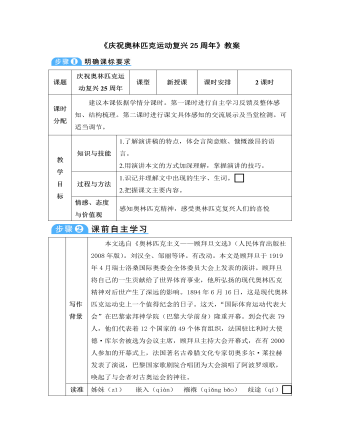
部编版语文八年级下册《庆祝奥林匹克运动复兴25周年》教案
2004年的雅典奥运会上,孔令辉获得冠军时忘情地亲吻胸前的国徽时,王军霞夺得金牌后激动的身披国旗绕运动场奔跑时,我们的泪水也会与领奖台上以手抚着胸前国徽高唱国歌的运动员的热泪一起落下。为了看体育比赛,我们甚至不惜守候到半夜而无怨无悔。在半夜看比赛时,我总在想:是什么让我们“为伊消得人憔悴”,为什么“总有一种力量让人泪流满面”。现在我有了答案:那是一种奥林匹克精神在激励着我们,在提升着我们。奥林匹克精神的内涵是丰富的。国际奥委会主席罗格在其就任宣言中指出:“奥林匹克的格言是更快、更高、更强。在新世纪来临的时候,或许对体育来讲需要新的格言,那就是更干净、更人性、更团结。” 奥林匹克精神让我们振奋,今天我们就来学习这篇课文《庆祝奥林匹克运动复兴25周年》。
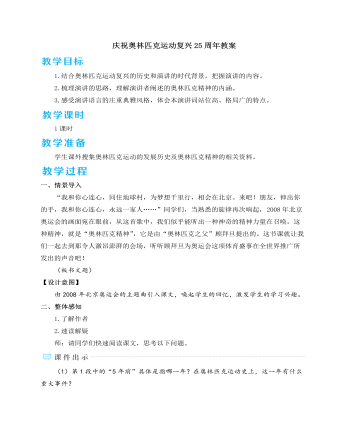
人教部编版语文八年级下册庆祝奥林匹克运动复兴25周年教案
(3)推荐男女生代表各一位在全班进行演讲展示。 (4)围绕“讲”和“演”两方面的技巧,点评演讲效果。(生开展演讲活动,师指导)【设计意图】本环节通过集中梳理演讲技巧,并设计演讲技巧进行演讲展示,引导学生将理论知识逐步运用于具体的演讲实践中,提高学生的演讲能力。五、总结存储1.教师总结现代奥林匹克运动的创始人顾拜旦面对世界政治格局剧变的局面,以战略家的视野指出奥林匹克精神的内涵与价值,用诗歌般的语言阐述了奥林匹克平和自信的内涵,提出了奥林匹克运动的宗旨是教育,是面向大众,是促进和平、公平、公正。他激情澎湃地畅想美好前景,确信奥林匹克精神必将如阳光般普照大地。整篇演讲词站位高、格局广,语言庄重、典雅,值得我们用心体会。2.布置作业学校即将举行春季运动会,如果你被邀请在运动会的开幕式上作为学生代表发言,你将如何演讲?结合你对奥林匹克运动的精神的理解,写一篇300字左右的演讲词,并适当设计一些演讲技巧。
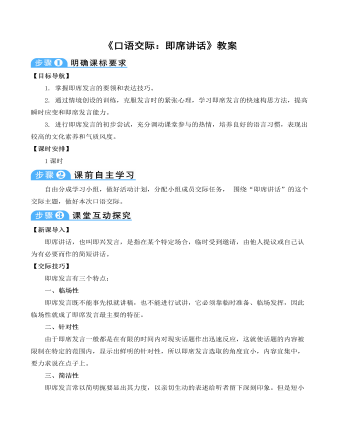
部编版语文八年级下册《口语交际:即席讲话》教案
【目标导航】1. 掌握即席发言的要领和表达技巧。2. 通过情境创设的训练,克服发言时的紧张心理,学习即席发言的快速构思方法,提高瞬时应变和即席发言能力。3. 进行即席发言的初步尝试,充分调动课堂参与的热情,培养良好的语言习惯,表现出较高的文化素养和气质风度。【课时安排】1课时自由分成学习小组,做好活动计划,分配小组成员交际任务, 围绕“即席讲话”的这个交际主题,做好本次口语交际。【新课导入】即席讲话,也叫即兴发言,是指在某个特定场合,临时受到邀请,由他人提议或自己认为有必要而作的简短讲话。【交际技巧】即席发言有三个特点:一、临场性即席发言既不能事先拟就讲稿,也不能进行试讲,它必须靠临时准备、临场发挥,因此临场性就成了即席发言最主要的特征。
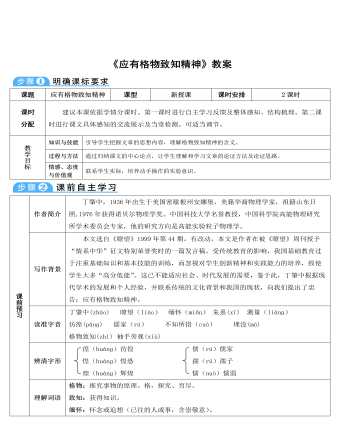
部编版语文八年级下册《应有格物致知精神》教案
【深入研读,探究方法】1.思路清晰、缜密。开头紧扣论题,由“格物致知”的出处,引出对其含义的理解以及我国古代并不重视真正的“格物致知”的原因分析,澄清人们的错误认识;接着作者从实验过程的两个特点、中国学生存在的问题和作者自己的亲身经验三个方面分析真正的“格物致知”精神的重要性;最后指出真正的“格物致知”精神的两个意义,并发出号召。全文思路清晰,说理严密。2.举例论证、道理论证和对比论证相结合,论述充分有力。文章在列举事例时,采用正面事例和反面事例相结合的说理方法。如反面事例,文中第4段举了王阳明“格”竹子的事例,证明了中国传统的教育并不重视真正的格物致知;在第11段摆了中国学生大都偏向理论轻视实验的事实;第12段又举了自己到美国念物理时吃的苦头。
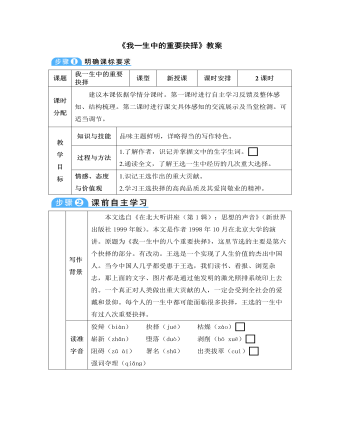
部编版语文八年级下册《我一生中的重要抉择》教案
(1)一个快落山的太阳,跟大家讲的,更多的是自己一生奋斗过来的体会。指61岁的老人。(2)加入人家说我是权威,也许还马马虎虎。作者自谦的说法,指成绩还过得去。(3)明明是一个过去时态,大家误认为是现在时态。指作者认为自己不适合再做权威了。(4)扶植年轻人我觉得是一种历史的潮流,当然我们要创造条件,就是把他们推到需要刺激的风口浪尖上。比喻重要的岗位或市场的前沿。【感悟精彩句子】1.所以我知道自己是一个下午四五点钟的太阳。各位呢,上午八九点钟的太阳,这是本科生;硕士生呢,九十点钟的太阳;博士生呢,十点十一点钟的太阳。比喻,拉近了与听众的距离,倍感亲切、期望和鼓舞。2.所以1992年前电视台采访我,我基本上都拒绝了。透过细节,体现了坚持不懈的科研精神。
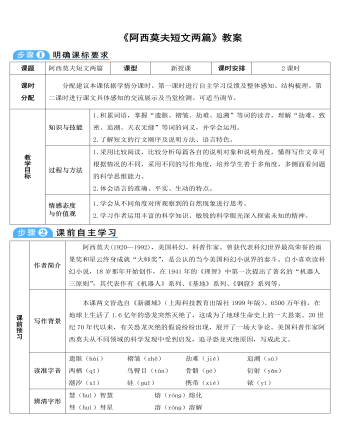
部编版语文八年级下册《阿西莫夫短文两篇》教案
第一部分(第1~4段),提出关于6500万年前恐龙灭绝的问题,目前存在的两种对立的理论,即“撞击说”和“火山说”。第2和第3自然段先后举了两个例子提出了关于“撞击说”和“火山说”这两种观点。第二部分(第5段至全文完),通过对“被压扁的沙子”的反思,证明外星撞击导致恐龙灭绝,支持“撞击说”。这部分又分四层。第一层(第5、6段),说明关于恐龙灭绝的原因不仅仅是一个学术问题,我们以后也许还会遇到这种情况,因此,科学家们一直都在努力寻找证据来验证这两种理论。第二层(第7~10段),说明1961年一位苏联科学家发现了“斯石英”,并且介绍了它的性质,为下文佐证“撞击说”奠定了基础。第三层(第11~13段),说明斯石英不仅可以在实验室制造,而且它在自然界中是可以存在的,不过它们只出现在沙子被强烈挤压的地方。由此推断撞击是可以产生斯石英的。事实也证明,火山喷发是不会产生斯石英的,从而进一步佐证了“撞击说”。

人教版新目标初中英语七年级下册How was your weekend教案2篇
Teaching Goal:1. General aims:Talk about recent past events2. Particular aims:A. Language Focus.Talk about recent past events and think of the past events.B. Language goalsHow was….?It was …What did …do over the weekend?C. Language structures:(1). How was your weekend? I was great. Pay attention to no form.(2). What did you do over the weekend? I played soccer. We went to the beach.D. Useful words and phrases:Words: was, did, went, beach, over, project, test, wasn’t, false, number, geography, spend, week, most, mixture, their, had, little, cook, read, saw, change, everyone, sit, sat, no, anythingPhrases: did one’s homework, played soccer, cleaned my room, went to the beach, played tennis, went to the movies, on Saturday morning, over the weekend, cook … for, what about, do some reading, have a party, talk show, go shoppingE. Grammar language:Present simple past tenseRegular and irregular verbsF. Learning strategies:Tour and holidaysG. Interdiscipinary:H. Emotion and manner:Teaching time: 5 periodsTeaching procedures:Period One教学步骤、时间 教师活动 学生活动 媒体应用Step 1Free talk 3’ Ask some questions like:Who’s on duty today?What’s the weather like? Answer and talk about something.让同学们回答下列问题1. Do you like weekend? (Let some students answer)It takes them three minutes to talk about the question.2. Why do you like weekend? (let the students answer) Most of the students like the weekend此时教师用汉语问:“在周末期间问你干了什么?这句话用英语这么回答?Let the students guess.At last the teacher give them right answer3. What did you do over the weekend?(板书、学习)

人教版新目标初中英语七年级下册What does he look like教案3篇
所需要用到的句子:Who is that?That is Jack. I like him.Why do you like him?I like him because he is interesting.Task 4: 设计理想中的人类Step one: 设计理想中的人类的外貌。把全班同学分成若干小组,学生可以边说边在纸上画出他们的模样。Step two: 设计理想中人类的性格。学生们可以把那些能描述性格的单词写在图画的旁边。Step three: 每组选出一名同学,其他同组同学提问,他作简单回答,并说明原因。所需用到的句子:What does he or she look like?He or she ...What is he or she like?He or she is ...Why?Because ...Task 5: 挑战性活动调查性格是天生的还是后天形成的,让每个同学回家去调查一下自己成长过程中性格是否有变化,具体是怎样的,为什么会这样? Teaching Aims:1. Enable students to have a general understanding of how to talk about people's physical appearance.2. Enable students to tackle some essential vocabularies and patterns about describing people. Provide them with necessary skills and methods.3. Create various chances for students to describe the persons they're familiar with, such as classmates, family members, teachers, idols, etc.

人教版新目标初中英语七年级下册Don’t eat in class教案2篇
Don’t fight. =You can’t fight. (板书,教读)教师把这些句子板书在黑板上,并请学生大声整齐地读祈使句和“can’t”句型,并让学生注意两种句型表达形式的不同和转换,“Don’t …=You can’t…”;并对学生说:These are our school rules. (板书,教读) You can’t break the school rules. Don’t break the school rules.(板书,教读)步骤3 :Practicea. T: Now, each of the students is breaking one of these rules.Please finish 1a.学生看图,完成1a的内容,检查答案并大声朗读校规。b. 听录音,完成1b,选出四位学生都违反了哪条校规;听之前,学生要读会英文名。c. 请两位学生朗读1c部分的句型;要求学生两人一组对话表演,SA扮演外校转来新生,SB告知本校校规。(学生可经过讨论,多说出他们想到的校规,不必只限于书上;教师应给予帮助)2) 第二课时(2a~4)步骤1 :warming up of revisionT: What are the rules at your school?学生使用“can”或祈使句表达各条校规;其中老师可引出“eat in the cafeteria outside”的表达。步骤2 :Practicea.T: Christina is an exchange student. She doesn’t know the rules. Let’s listen, what activities they’re talking about?学生听第一遍时,完成2a;第二遍时,完成2b;b. 请学生领读2c部分,看着2a完成的表格,理解2c活动的要求;分成小组针对2a进行问答;

人教版新目标初中英语七年级下册It’s raining教案2篇
1 Each group choose one place to describe and what you are doing in it Choose one place, and describe what they are doing 2 Move around the room and give suggestions Talk about it and write it down 3 Ask one to show their works and act it Choose one of each group to make a report 4 Evaluate the best group and the best reporter Choose the best one Homework Ask your friends their ideal place and write about it教学反思:新课程标准中强调学生在课堂中的主体地位,在综合课中他们的主体地位就更加突出。在各个活动中给不同程度的学生不同层次的任务,让各层面的学生都有表现发挥的机会,从而产生对英语的兴趣。使用照片图片多媒体来辅助教学,效果更好。同时让了解其他国家风景,风俗的同学介绍ideal place,增加学生的背景知知识,实现跨学科交流的目的。教案点评:采用任务型教学模式,在各个活动中给不同程度的学生不同层次的任务,让各层面的学生都有表现发挥的机会,从而产生对英语的兴趣。使用照片图片多媒体来辅助教学,效果更好。让了解其他国家风景,风俗的同学介绍ideal place,增加学生的背景知识,实现跨学科交流的目的。

人教版新目标初中英语七年级下册What do you think of game shows教案
五、教学Section B-2c1. Pair work: What do you think of the belt/sunglasses/…? What does your father/mother/… think of your scarf/belt…?2. Group work(1). Teacher shows some different kinds of school uniforms (制服)and asks : “ What do you think of your school uniforms? If you have a chance to choose your school uniforms, what kind would you like to choose?”(2). Discuss in groups.(3).Get some Ss to report in class.说明:这一步旨在让学生运用已有的语言知识谈论对事物的看法和意见,并简单阐明理由,培养学生的主动思维能力和运用英语的能力。六、教学拓展调查电视节目的收视率任务:调查你周围的人对现在各种电视节目的反响。活动过程:1.教师布置任务,让学生调查周围的人(包括他的亲戚朋友和邻居)喜欢收看哪方面的电视节目。2.学生进行调查活动,运用本单元所学的句型What do you think of….? (Why?)What's your favorite game shows?What do you think of talk show?I doesn’t mind it.I like it.I love it.I can’t stand it.3.记录下排在前10位的TV Program,填写调查表,比较其收视率。

人教版新目标初中英语八年级下册Have you ever been to an amusement park教案
(1)Have you ever been to …? Yes, I have. / Yes, I have ever been to …No, I haven’t. / No, I have never been to …(2)When did you go there? I went there last year. (3)I have never been to a water park. Neither have I. I have ever been to an amusement park. So have I. (4)How long have you been studying English? I’ve been studying English since nine o’clock. I’ve been studying English since I came back home. I’ve been studying English for five hours. (5)What’s that? It’s an amusement park in Japan. I’ve never been to an amusement park like it before. It’s fun to learn another language. Let’s go tonight. Isn’t this great?space museum, amusement park, water park, South America, Peru, Holland, European culture, tour guide, flight attendant, musical instrument, more than, be from, get to, take lessons, neither, discover, graduate, change

人教版新目标初中英语八年级下册If you go to the party, you’ll have a great time教案2篇
区分宾语从句、定于从句和状语从句宾语从句和状语从句,都叫做主从复合句。宾语从句主要是中考必考的,是初中阶段必掌握的从句,宾语从句主要是掌握三要素,所谓宾语从句,就是宾语在主从复合句当中充当宾语的一个句子,叫做宾语从句。主句的谓语动词是及物动词,后面如果是词或者是短语的话,是简单句,如果是句子的话,肯定是宾语从句。I know that he good at English.就是宾语从句,三要素,一要素是要注意连词,连词一共学了三类连词,一类连词是that口语当中可以省略,就像刚才说的那一句,I hear he is good at English.还有疑问代词、疑问副词,how where when,疑问代词、疑问副词。还有一类连词weather是否的意思,不是状语从句当中的如果,这一定要和如果区分开,这是是否。I don't know if he interested at English。宾语从句要注意if是连词。第二要素是语序,要用陈述举语序。比如说你家有几口人,我们都说How many people are there in you family?但是这是简单句,一旦说成宾语从句,你可以告诉我你家有几口人吗?Could you tell me how many people there are in you family ?

人教版新目标初中英语八年级下册It’s a nice day, isn’t it教案2篇
"Hello! Welcome to English class! Introduce yourself. Meet your new classmates." That's what the teacher says. What do you say? "Oh no!" It can be difficult talking to new people. But it can be fun, and you can make friends. How do you do it? Make small talk. Small talk is polite conversation. "Wang Nan is a great pingpang player, isn't she?" "I'd love to meet her, wouldn't you?" "It's been raining a lot, hasn't it?" Tag questions are a form of polite speech. To make small talk successfully, you should know how to make them. You should also know what topics to talk about. Try to learn this unit carefully. The next time you're in English class, you'll find out. Making small talk's easy, isn't it? (“你好!欢迎你!请做一下自我介绍。认识一下你的新同学。”通常在课上老师会这样说。你会说什么呢?“噢,不!”与陌生人谈话太困难了。但是这也很有意思,并且你还能交到朋友。你该怎么做呢?闲聊。闲聊指得是礼貌的对话。“王楠是一个很棒的乒乓球运动员,不是吗?”“我希望自己能认识她,你呢?“今年的雨水很多,不是吗?”反意疑问句是一种礼貌用语。为了使得谈话成功,你应该知道怎样去进行闲聊。你还应该知道与不同的人该谈论什么样的话题。认真的学习这个单元吧,下次在英语课上,你会发现与大家展开谈话是一件很容易的事情,不信我们来试试。)

人教版新目标初中英语八年级下册He said I was hard-working教案2篇
This activity introduces some new vocabulary and provide oral practice using the target language.Task 1 . Ask four students to stand in front of the class, and the teacher asks them the following questions as a reporter.1.What are you going to do when you grow up?2.What are you going to do next week?3.What are going to do after school?The students will give different answers, then ask a good student to report what they said.I am going to e a doctor.What did she say?----------She said she was going to be a doctor.I am going to have a party on Friday night.What did he say?-------He said he was going to have a party on Friday night.I am going to do my homework.What did she say ?------ She said she was going to do her homework.I am going home after school.What did she say?-----She said she was going home after school.Say In this unit we are going to learn to use words like to report what someone said.Task 2. Read the instructions. Then ask a student to read the four questions. And write the words on the Bb. Explain what soap opera is.Task 3. Ask the students to Look at the pictures, point out the TV screens in the picture. Ask one girl to read what Marcia said.What did Marcia say? She said She said she was having a surprise party for Lana on Friday night. Repeat the other pictures in the same way.Activity3. Listen and number the pictures in activity 1a.

人教版新目标初中英语八年级下册How long have you been collecting shells教案2篇
Step Ⅱ Show the new words on the screen and teach the new words. Read the new words to students and ask them to repeat.Step Ⅲ 3aThis activity introduces new vocabulary and provides reading practice using the target language.In this activity first look at the four pictures.T: What can you see in the pictures?Ss: Four snow globes.T: Right. There are four snow globes in the pictures. And what are they?Ss: They are a monster, two polar bears, two penguins and a birthday cake.Write these words on the blackboard: snow globe; monster; polar bear; penguin and birthday cake. Read them to the class and ask students to repeat each one. Make sure students understand each word.Use a computer to show the E-mail message on the screen and read the message to students.Get students to read the e-mail on their own, and then draw lines connecting each snow globe and its description.Correct the answers.AnswersA line should connect each snow globe picture with the words that describe it in the letter.Step Ⅳ 3bThis activity provides writing practice using the target language.First review Activity 2a on Page 47.Then ask students to complete the message according to Activity 2a.Some partial sentences are given to students. Write about one person's collection.When students work, walk around the room checking the progress and offering help as needed.When they finish, ask some students to read their messages to the class.

人教版新目标初中英语八年级下册What were you doing when the UFO arrived教案2篇
(一).知识方面: 1.培养学生能运用过去进行时来描述、谈论过去某个时间正在发生的事情或动作的意识和能力,能就过去某个时间正在发生的动作做出正确的描述。 2.培养学生的想象力和角色扮演的合作能力。 3.培养学生讲述过去发生的事情经过的能力。能正确运用一般过去时来讲述故事。 (二).技能方面: 1.本单元的语言目标是Talk about past events and tell a story(谈论过去的时间和讲述一个故事),围绕这一目标,要涉及句型: What were you doing when the UFO arrived? ----I was sitting in the barber’s chair. The barber was cutting my hair. 因此必须学习standing、studying、cleaning、sleeping、cooking、making、eating、cutting、等表示地点的词,以便为上述句型提供语言材料。2.学习过去进行时的有关知识。Was/were+现在分词,是该时态的表达式。 3.在学习过程中,要区分The boy was walking down the street when the UFO landed.和While the boy was walking down the street, the UFO landed.这两种由when和while引导的状语从句的句型结构。注意它们的不同。

人教版新目标初中英语八年级下册Would you mind turning down the music教案
Step 4. Group work (4)1. Ask a pair of students to read the dialogue. Say, This activity provides speaking, listening and writing practice using the target language.2. Ask students to complete the work in groups.3. Check the answers with the whole class. 4. Explain some of the language points. Step 5. Word review (Self check 1)1. Ask students to read the words and the phrases given. 2. Fill in the blanks with proper forms of these words to complete the sentences. 3. Check the answers with the whole class. Homework:Do activity 2 on page 57 after class. Period 6Teaching aims: 1. Teach vocabulary words and the useful expressions. 2. Enable the students to learn etiquette in different culture. 3. Help the students learn how to behave politely in public places and in daily life. Teaching procedures:Step 1. RevisionHelp students to review the function of making requests through a free talk. Then lead them to the topic of etiquette. Explain the meaning of etiquette. Or, ask students to look it up in the dictionary. Step 2. Pre-reading (Section 1)1. Ask students to read the picture and make a list with their partner about how many rules of etiquette can be seen being broken.
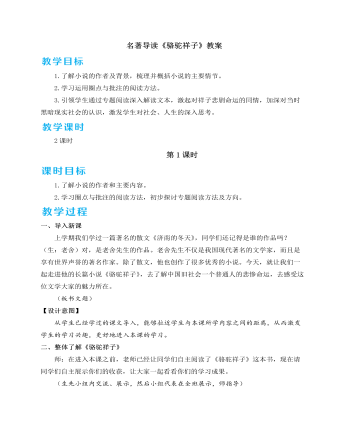
人教部编版七年级下册名著导读 《骆驼祥子》 圈点与批注教案
本环节交流的内容侧重于体验与心得,是建立在充分阅读后的再创作,也是对小说阅读方法和内容的总结性归纳和展示,需要学生有较高的阅读理解能力。三、延伸探讨《骆驼祥子》的艺术特色师:同学们,了解经典作品的艺术魅力,然后能运用到自己的写作中,是何等快乐的事啊!请你根据自己的阅读体验,概括对《骆驼祥子》这部小说艺术特色的评价。(生小组内交流、讨论,然后推荐代表在全班交流,师明确)预设 (1)结构紧密,线索分明。(2)语言朴实自然,生动明快,具有鲜明的地方色彩和浓厚的生活气息。幽默和“京味儿”语言运用熟练。(3)善于运用各种描写方法(肖像、心理、环境描写等)来表现人物的思想性格及发展变化。(4)有深厚的文化底蕴。写北京的生活,北京的车夫,北京种种的风俗人情等。在炎凉的世态中揭示地方文化。
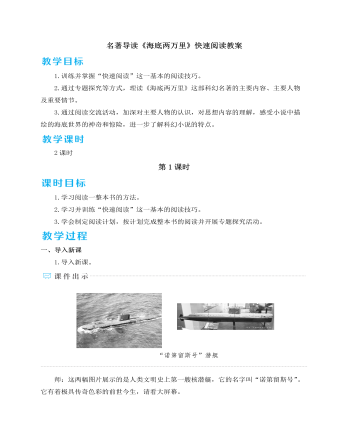
人教部编版七年级下册名著导读《海底两万里》快速阅读教案
【设计意图】这三个活动对培养学生的思维能力各有不同的目的和针对性。绘制航海路线图,讲述旅途精彩故事,可以帮助学生梳理全书的故事情节;写航海日记让学生深入到作品的情节中,对几个主人公的形象有更深入的理解;主题辩论既让学生对人物形象有更深入的思考,也有助于学生深入理解作品主题。三、活动结语师:读完《海底两万里》,相信同学们心中一定还有很多没有得到解答的疑问。尼摩船长的身世究竟是什么?他的亲人是怎么死的?他为什么要复仇?“诺第留斯号”潜艇最后的结局是什么呢?想要解开这些谜团,请看凡尔纳的另外两部科幻小说《格兰特船长的儿女》《神秘岛》,它们会带你揭开这些谜底。【设计意图】本环节旨在激发学生拓展阅读的兴趣,引导学生课外阅读凡尔纳的另外两部作品,扩大学生的阅读量。


